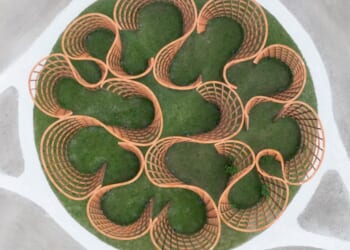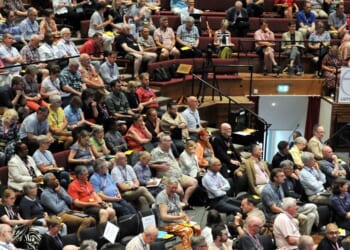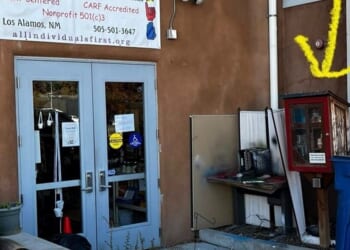IN THE gardens of the Livadia Palace, in Yalta, political and military leaders assembled after the end of the Second World War. There are numerous images of their gathering, taken by photographers from various angles. In 2015, the National Portrait Gallery purchased one of them: Richard L. Sarno’s photo was distributed by the United States Army Signal Corps in February 1945.
The image, taken at an angle, is a close up of Winston Churchill, Franklin D. Roosevelt, and Joseph Stalin, sitting on a bench. Each has a different stance; considering the event, the photo shoot was remarkably informal. Beneath them on the floor there is a sumptuous Persianate white ground carpet. Sarno’s photo features its pattern to the right of Stalin’s glistening boot. This is one of the 12 carpets that the historian Dorothy Armstrong features in her “history of the world” through the lens of this unique and yet radically diverse material culture.
Each carpet’s history unfolds through Armstrong’s detailed attention to the techniques and materials, alongside the many people — named and unnamed — who loved them, cared for them, neglected them, and misunderstood them. Whether readers are drawn to this book because of its focus on empire and geopolitics, colour and iconography, or museums and institutions, Armstrong’s writing is compelling and biographically illuminating.
 AlamyThe victors of the Second World War in the Livadia Palace Gardens, Yalta, have their feet on a white-ground Persianate carpet
AlamyThe victors of the Second World War in the Livadia Palace Gardens, Yalta, have their feet on a white-ground Persianate carpet
The chapter titled “Tycoon” focuses on the opulent and vast art collection assembled by John Paul Getty, the extravagantly wealthy American founder of the Getty Oil Company. His interest in carpets is a tale told through a controversial authentication debate. Was it a fake? Getty cut out a small section of its delicate wool, and got to work.
The challenger was the renowned carpet historian and curator May Beattie. She and her husband had lived and worked in Baghdad. Their house was robbed soon after they arrived, and her expertise in carpets began with the necessity of replacing her furniture. She discovered her vocation by learning from carpet-sellers and -makers. Beattie became a refugee, fleeing the violence of the Second World War. She travelled for thousands of miles to seek sanctuary in India, and the carpet collection was lost.
Within Armstrong’s chronology of 12 carpets, beginning more than 2000 years ago and arriving in the 21st century, the joys, sorrows, journeys, and uncertainties of the carpets themselves are interwoven with the lives of sultans, political activists, and even priests.
What about the weavers? Across the centuries, they produced carpets that became obsessions, decorations, and everything in between. In the 1990s, the Iranian filmmaker Ghasem Salimi documented the lives of women who weave sofreh rugs for kneading bread. The people who make them are underpaid, exhausted, and angry. An elderly woman with aching arthritis said, “Now you’re willing to pay a good price for sofreh, I can’t weave them.” Another said, “They consumed our time, but it was our life they consumed.” Every thread has a story.
The Revd Dr Ayla Lepine is Associate Rector of St James’s, Piccadilly, in London, and an art historian.
Threads of Empire: A history of the world in twelve carpets
Dorothy Armstrong
Orion £30
(978-1-3996-1422-1)
Church Times Bookshop £27

















